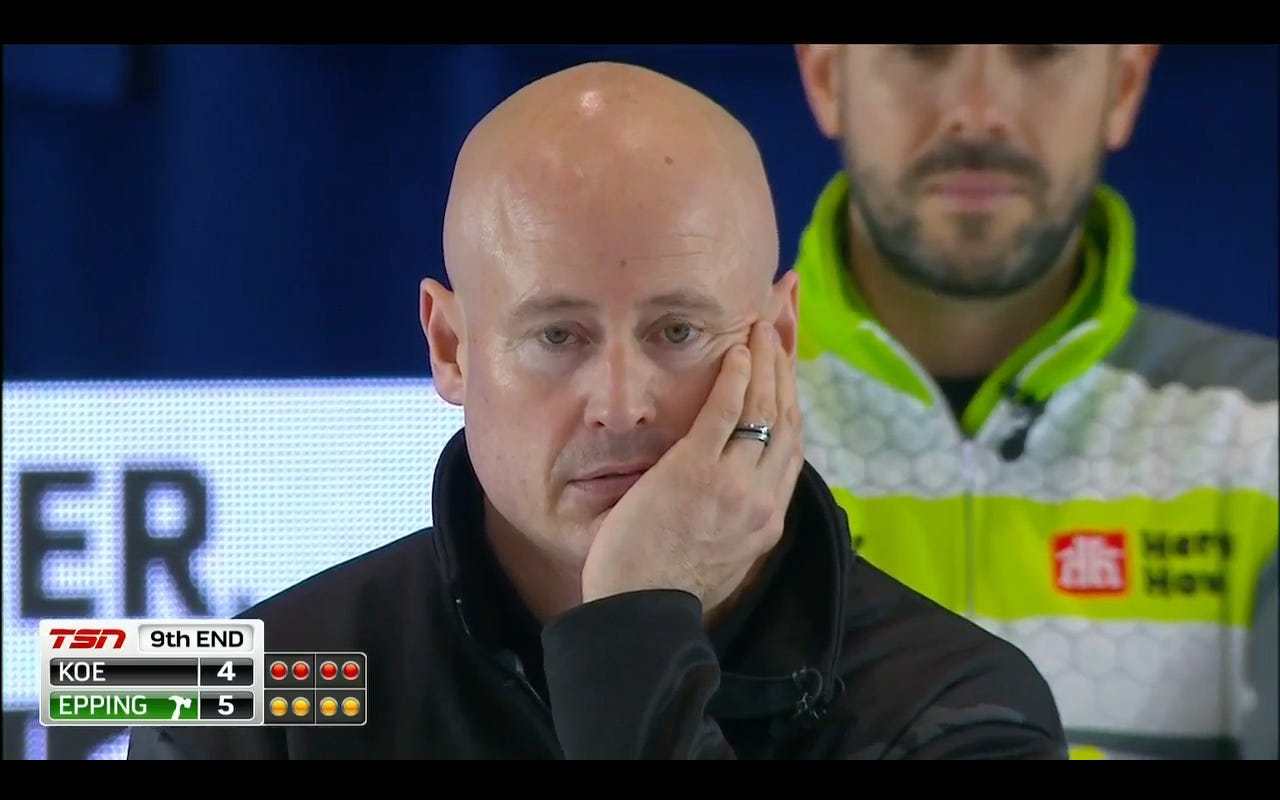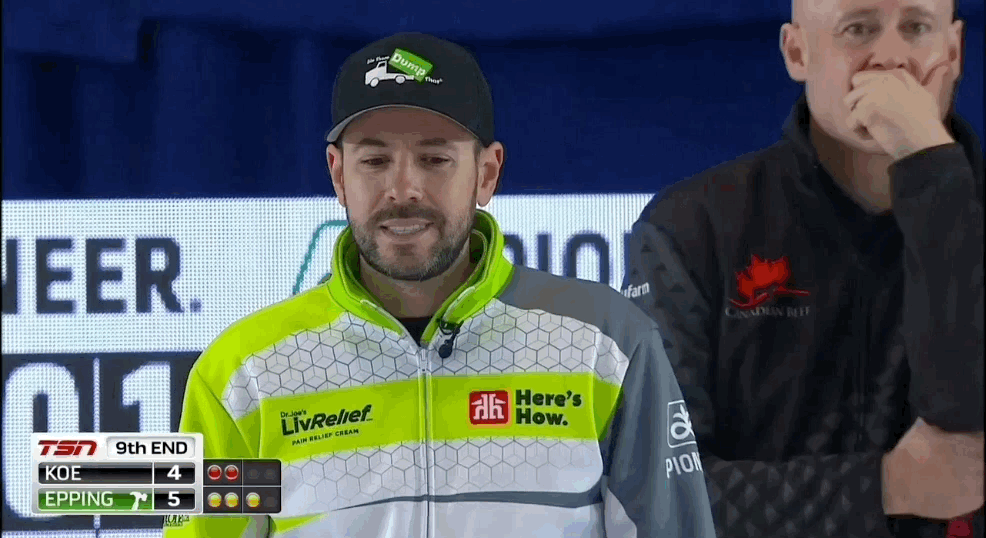The best, absolute best, part of watching curling is the strategy and thinking about what you would throw in any situation. It’s 90 percent of what the announcers discuss. And it’s all we discuss when watching a game as well. It’s awesome. The 9th end between teams Kevin Koe and John Epping was a quintessential example.

Ben Hebert threw his two center guards, and Brent Laing tossed a pair of yellows into the four-foot. They’re a bit pocketed which helps Koe, and right at this moment there was discussion between Koe and the rest of his team if they wanted to double off those yellows right away. Koe’s vice B.J. Neufeld made the reminder that the goal of the end is to force Epping to one point only. They don’t want to blank. Epping wants to blank! Probably … although Epping traditionally doesn’t like blanking. He probably wanted to score two.
The call was back house weight to set up a pocket. Colton Flasch delivered.

So far so good for Koe.
We call a lot of guards in club play, and for good reason: they’re sort of easy to make. Guards help score points. Guards help steal. We don’t, however, seem to call peels in club. Not a lot of frontend players have the takeout reliability to hit and roll out on a called peel. So you’d be tempted to try and play another guard to protect against any yellow tap. I would be as well.
Epping was nearly talked into playing a normal hit on the red, doubling off the yellow behind it and possibly rolling their thrown rock behind cover. But then that would give Koe a chance to draw around everything and there’s your steal point.
So Epping peeled a guard.
It was then Koe’s turn to fire off some synapses, debating between a guard and going for the tap right now. He had Flasch throw a soft back line tap that really mashed their stone into a better pocket. The shooter went into a usable spot as well.

Epping sees the impending doom and peeled off the guard. Everything’s in the house now, and it’s looking better for him to get out of this end. Koe has a decision now. He settled on a straight guard. The rest of his team was worried about a potential runback double with that choice.

It’s the face of a man, who has broken the hearts of several men on the ice with insanely good takeouts, that doesn’t like what he sees. He hasn’t like what he’s seen for eight ends. He knows this ninth is going to decide the championship, the Trials spot (which he’s going to get eventually). He just wants to throw a damn guard and “hope for a miss.” After a timeout and a rather forlorn strategy sesh, they agreed on a guard placement.
Epping then went for the peel/runback. They hoped for a miss and sort of got it.

That side red really isn’t the important one, but those side ones never are, are they? The main event is happening in the four-foot! But at this level, forcing requires two stones. The one on the wings is just as important. Koe’s force is still in effect, and they replaced the center guard.
The next exchange might have been my favorite. Ryan Fry sort of led the discussion on playing off that side red rock again and rolling in, maybe catching part of the other red and pushing it a little left. It’s a tough shot but it does a lot of good things for them.
Epping: Is this right, Lainger?
Laing: Yeah, probably not.

Another timeout is called. The year is now 2065 and civilizations have fallen. Rogue bands of mercenaries are ruling the countryside. Fry still wants to throw this peel double.
And after the timeout, a bit of air is cleared and they still settle on the hit and roll. It’s not a bad result, but it’s probably what Koe wanted him to do (eliminate the possibility of a blank end) and it also froze the red onto a yellow.

Koe’s decision was pretty simple, get to the yellow on the button. Hit ‘em both out. The question was whether his shooter should go left at all, and how much. There was probably no triple, thanks to the center guard. I’d have gone for a nose hit, rather than a roll, and you’ll see why.

Epping then attempted a double on the two reds with his first, but crashed on the guard.
We call the last rock the “hammer” for its violent, forceful imagery. We need a good nickname for the last rock of the steal team, and if we’re going full communism we could call it the “sickle.” Do we all like that? I’m going to call it the sickle until something better comes along. It’s the most important shot here, because at this point strategy is no longer a factor. You get into the eighth stone, it’s all about execution.
Koe probably would’ve prefer to throw a pick, but that probably results in a blank, and he should lose the game on principle of that end, with so much strategy, to become a blank. So he needs to hit the lower red into the yellow with soft weight. Kevin Koe can throw soft weight! He did it to win the Brier.
Look at what Koe had here:

It’s easier to say he should have done ______ after the fact (and more fun too!). The goal is for a force. I understand no yellow in play means no chance for two, but I would have opted to throw a top right stone to basically guard the four-foot, or slightly rub off the right-hand red rock and spread out the three reds. Maybe a triple would have ensued. But it would have forced Epping to make somewhat of a difficult shot on his last, rather than an open hit for two. Look at this. This would have resulted in a very tough (but makeable shot):

Instead it resulted in this shot:

Great if it’s hammer! Not if it’s sickle.
Anytime someone asks me about strategy, because sometimes it’s a big foreign and scary subject, I mention that it’s important to understand smart calls and when it’s a good idea to go for risky shots, but in the end good strategy isn’t worth a lick if you can’t make the shots that are called. Strategy is simply a vehicle to get you into a position to make that final shot as easy/hard as possible. It was a terrific cat-and-mouse end by both teams, which resulted in Koe’s first shot sort of made (though had an unfortunate bounce).
Then Epping missed. Then Koe missed.
See? Professional athletes. They’re just like us.

